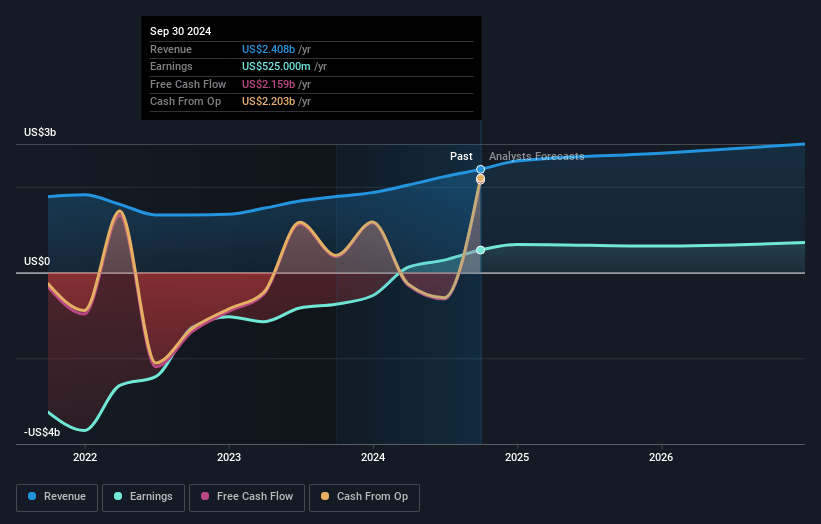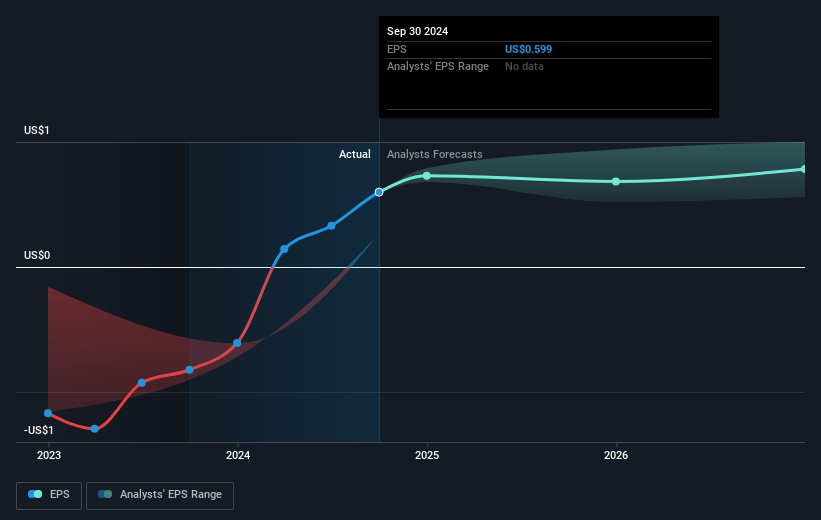Key Takeaways
- Expansion into futures, crypto, and new asset classes boosts trading volumes, enhancing transaction revenue and platform engagement.
- International expansion and focus on institutional services aim to diversify revenue and grow earnings through new markets and business avenues.
- Regulatory uncertainty and competitive pressures in crypto and expansion efforts pose risks to Robinhood's growth, revenue, and margins amidst evolving market conditions.
Catalysts
About Robinhood Markets- Operates financial services platform in the United States.
- Robinhood's expansion into futures and prediction markets, with substantial growth in trading volumes, suggests potential for increased transaction revenue. The early success is forward-looking as they continue to broaden contract offerings.
- The rapid growth of Robinhood Legend, with new asset classes like crypto and index options, indicates increased platform engagement and trading volume, supporting revenue growth through active trader services.
- The upcoming rollout of Robinhood Banking and the accelerated adoption of the Gold Credit Card signal potential for higher revenue and increased wallet share, contributing to margins as users deepen their financial engagement.
- The planned international expansion into markets like Asia, alongside existing progress in the U.K., predicts growth in customer base and accompanying revenue, benefiting from a more global financial ecosystem.
- Robinhood's increased focus on institutional services, evidenced by the acquisition of TradePMR and anticipated Bitstamp acquisition, aims to diversify revenue sources and increase earnings by tapping into new business-to-business avenues.
Robinhood Markets Future Earnings and Revenue Growth
Assumptions
How have these above catalysts been quantified?- Analysts are assuming Robinhood Markets's revenue will grow by 11.8% annually over the next 3 years.
- Analysts assume that profit margins will shrink from 48.8% today to 32.8% in 3 years time.
- Analysts expect earnings to reach $1.5 billion (and earnings per share of $1.67) by about May 2028, down from $1.6 billion today. However, there is a considerable amount of disagreement amongst the analysts with the most bullish expecting $2.1 billion in earnings, and the most bearish expecting $934.0 million.
- In order for the above numbers to justify the analysts price target, the company would need to trade at a PE ratio of 44.2x on those 2028 earnings, up from 27.0x today. This future PE is greater than the current PE for the US Capital Markets industry at 25.0x.
- Analysts expect the number of shares outstanding to grow by 0.41% per year for the next 3 years.
- To value all of this in today's terms, we will use a discount rate of 7.64%, as per the Simply Wall St company report.
Robinhood Markets Future Earnings Per Share Growth
Risks
What could happen that would invalidate this narrative?- Regulatory developments and uncertain legislative actions could limit Robinhood's ability to offer new products like tokenized private equities, affecting future revenue and growth potential.
- There are significant costs associated with planned expansions and acquisitions, such as the acquisition of TradePMR, which might pressure margins and earnings if anticipated synergies do not materialize.
- Robinhood faces increased competition in the crypto space, as new competitors might drive down pricing, impacting revenue from crypto transactions.
- Credit risk associated with Gold Credit Cardholders and potential increases in credit loss provisions could affect net margins if customer delinquencies rise.
- Dependence on active trading and market volatility for revenue may pose a risk; downturns or reduced trading volume in key areas might negatively impact earnings despite diversification efforts.
Valuation
How have all the factors above been brought together to estimate a fair value?- The analysts have a consensus price target of $59.292 for Robinhood Markets based on their expectations of its future earnings growth, profit margins and other risk factors. However, there is a degree of disagreement amongst analysts, with the most bullish reporting a price target of $105.0, and the most bearish reporting a price target of just $40.0.
- In order for you to agree with the analyst's consensus, you'd need to believe that by 2028, revenues will be $4.6 billion, earnings will come to $1.5 billion, and it would be trading on a PE ratio of 44.2x, assuming you use a discount rate of 7.6%.
- Given the current share price of $48.69, the analyst price target of $59.29 is 17.9% higher. Despite analysts expecting the underlying buisness to decline, they seem to believe it's more valuable than what the market thinks.
- We always encourage you to reach your own conclusions though. So sense check these analyst numbers against your own assumptions and expectations based on your understanding of the business and what you believe is probable.
How well do narratives help inform your perspective?
Disclaimer
AnalystConsensusTarget is a tool utilizing a Large Language Model (LLM) that ingests data on consensus price targets, forecasted revenue and earnings figures, as well as the transcripts of earnings calls to produce qualitative analysis. The narratives produced by AnalystConsensusTarget are general in nature and are based solely on analyst data and publicly-available material published by the respective companies. These scenarios are not indicative of the company's future performance and are exploratory in nature. Simply Wall St has no position in the company(s) mentioned. Simply Wall St may provide the securities issuer or related entities with website advertising services for a fee, on an arm's length basis. These relationships have no impact on the way we conduct our business, the content we host, or how our content is served to users. The price targets and estimates used are consensus data, and do not constitute a recommendation to buy or sell any stock, and they do not take account of your objectives, or your financial situation. Note that AnalystConsensusTarget's analysis may not factor in the latest price-sensitive company announcements or qualitative material.




